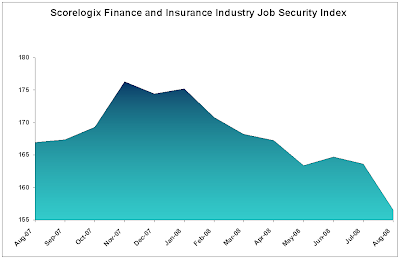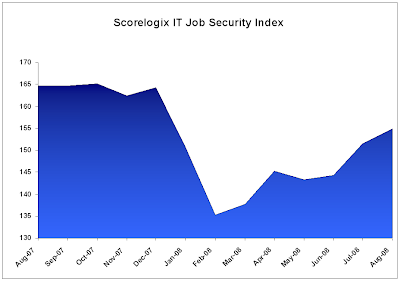
Nationwide Job Security Index Continues Downward Trend
3.3% Decline is Eighth Drop in Nine Months
The Scorelogix® Job Security Index™, a predictor of job security throughout the United State, declined 3.3% in August, the fourth such consecutive drop. These declines were widespread, affecting all nine US census regions, with more than 90% of all Occupational Categories tracked by Scorelogix recording negative growth.

Only two Occupational Categories managed to record positive growth in August. Construction and Extraction, as well as Installation, Maintenance, & Repair both increased in job security, 8.2% and 1.1% respectively.
Top Occupational Categories by Job Security Growth in August 2008 Occupational categories with the largest month-to-month increase in job security are listed
| OCCUPATIONS | Aug-08 | Jul-08 | Jun-08 | May-08 | Apr-08 | Mar-08 | Aug-07 |
| Construction and Extraction | 64.3 | 59.4 | 46.5 | 29.1 | 4.5 | -2.7 | 17.0 |
| Installation, Maintenance, and Repair | 147.8 | 145.4 | 157.2 | 164.4 | 170.7 | 166.8 | 167.6 |
| Management | 195.0 | 197.3 | 198.1 | 198.7 | 203.7 | 202.8 | 202.7 |
| Architecture and Engineering | 193.9 | 196.3 | 197.1 | 197.7 | 202.8 | 201.9 | 201.8 |
| Healthcare Support | 149.6 | 152.3 | 156.3 | 159.9 | 161.2 | 153.6 | 151.3 |
Meanwhile, of the top five Industries by Job Security in August 2008, only mining experienced job security growth. Real Estate, Public Administration, Educational Services, and Health Care all maintained their positions in the top five Industries, but each also scored lower than in July. Real Estate declined by 2.9%, Public Administration by 1.6%, and Educational Services and Health Care each by 4.6%.
Top Industries by Job Security Growth in August 2008
Industries with the largest month-to-month increase in job security are listed below.
| INDUSTRIES | Aug-08 | Jul-08 | Jun-08 | May-08 | Apr-08 | Mar-08 | Aug-07 |
| Mining | 199.9 | 192.9 | 172.0 | 170.6 | 170.7 | 174.2 | 182.3 |
| Construction | 77.2 | 74.6 | 62.3 | 41.2 | 11.6 | 7.8 | 24.0 |
| Information | 154.9 | 151.5 | 144.3 | 143.2 | 145.3 | 137.7 | 135.3 |
| Administrative & Support, Waste Management & Remediation Services | 22.0 | 21.6 | 28.0 | 43.6 | 55.1 | 37.0 | 23.8 |
| Agriculture, Forestry, Fishing and Hunting | 86.8 | 86.3 | 98.9 | 66.0 | 32.5 | 2.0 | 42.8 |
Mining’s 3.6% JSI expansion propels it to the top of the list in August for overall growth in JSI. Waste Management & Administration made the list with 1.8% growth, though its JSI score of 22 is dismal, and marks the first positive growth in the industry since April 2008. Since April, the Waste Management JSI has dropped by 61%, so the 1.8% gains registered in August do little to appease long term concerns.
Overall, the consistent decline in the National JSI indicates that the economy has yet to recover from the recent market turmoil, and that, in the short term, things will most likely be getting worse instead of better.
To obtain further information about Scorelogix’s Job Security Index, or to receive a more in depth analysis of the data provided above, please email Scorelogix
###




















